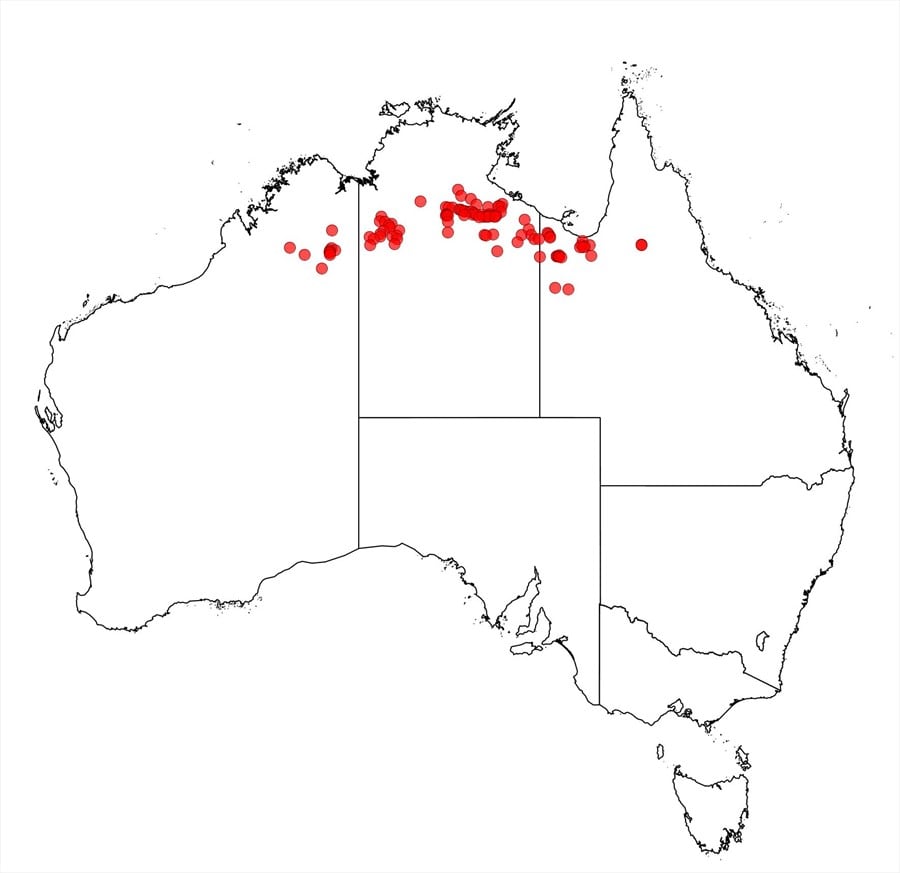Acacia calligera (Pedley) Pedley
WATTLE
Acacias of Australia
Family
Fabaceae
Distribution
Occurs in northern Australia from the Kimberley region, W.A., through N.T. to the Normanton area in NW Qld.
Description
Spreading, glabrous, resinous shrub mostly 0.5–1.5 m high, sometimes flat-topped. Branchlets with prominent, resin-crenulated ribs. Phyllodes patent to ascending, mostly ovate to elliptic or oblong-elliptic and often dimidiately so, occasionally ±orbicular, straight or rarely slightly recurved at apices, often slightly to markedly undulate, (0.3–) 0.5–1.5 (–2) cm long, (2–) 3–7 (–8) mm wide, l:w = 1–3, green to ±glaucous, marginal nerve yellowish, (3–) 5–7-nerved, the nerves widely spaced, obscure or pronounced and with the central one normally the most pronounced; apex with a small, slightly thickened, beak-shaped, curved mucro which is deflexed (not erect) and commonly ±adnate to phyllode margin; gland inconspicuous, 0.5–2 mm above the vestigial pulvinus. Inflorescences simple; peduncles (3–) 5–10 (–16) mm long; spikes (0.8–) 1–3.5 cm long, sulphur yellow to golden. Flowers 5-merous; calyx gamosepalous, shortly dissected; petals with prominent midrib. Pods ±narrowly oblanceolate, sometimes very narrowly elliptic to linear, basally tapered, straight-sided, flat, 2–6 (–9) long, (4–) 5–6 (–8) mm wide, firmly crustaceous to ±woody, obliquely nerved, opening elastically from apex, the dehisced valves recurved; margins thickened and pale-coloured. Seeds oblique in distinct chambers, narrowly oblong-elliptic, 3–3.5 mm long, brown to dark brown; areole open, with pale halo; funicle-aril narrowly turbinate.
Phenology
Flowers Feb.–Aug. (?Nov.); young pods often occurring with flowers.
Habitat
Grows in often red, sand or clay loams, or lateritic or skeletal soils, in shrubland or in open eucalypt savannah woodland with grass (often spinifex) understorey, on ridges, escarpments or plains. Sometimes forming dense thickets.
Specimens
W.A.: Tanami track, W of Halls Ck, D.Keith & B.Pellow 156 (NSW, SYD n.v.); 27.4 km S of Rockhole Stn, M.Lazarides 6367 (BRI, CANB n.v., NSW). N.T.: 35.2 mi [56.3 km] W of O.T. Downs, 11 Mar. 1959, G.Chippendale 5499 (CANB, DNA, K n.v., NSW, PERTH); Seigal Creek Outstation, S of Calvert Hills, N.M.Henry 770 (BRI, CANB, DNA, NSW n.v.). Qld: 18 km E of ‘Wernadinga’, Burketown–Normanton road, D.H.Benson 863 (NSW); between Cliffdale Ck and Westmoreland Stn, R.Pullen 9166 (CANB, DNA, NSW).
Notes
Plants of A. calligera from W.A. and western N.T. often have phyllodes that diverge at a more acute angle (i.e. ascending) than elsewhere. Also, the westernmost plants commonly have dimidiate phyllodes (i.e. lower margin ±straight, upper margin convex) whereas further east the phyllodes are normally symmetric with both margins convex.
Acacia wickhamii is most readily distinguished from A. calligera by the apical mucro of its phyllodes which is ±straight and erect (not curved or deflexed as in A. calligera); this character is best assessed on juvenile phyllodes. It is A. wickhamii subsp. wickhamii that is most likely to be confused with A. calligera but additional characters that are helpful in recognizing this subspecies are its phyllodes which are shallowly to strongly recurved towards their apices, consistently dimidiate and not or scarcely undulate. According to P.G.Kodela & M.D.Tindale, Flora of Australia 11B: 243 (2001), intermediates occur between A. calligera (syn. A. wickhamii subsp. viscidula) and A. wickhamii in the ‘Inverway’–‘Limbunya’–‘Wave Hill’ area of N.T., e.g. G.Chippendale NT5891 (DNA, PERTH), G.Chippendale NT5939 (BRI, DNA, NSW), C.Dunlop 3535 (CANB, DNA, MO), and between L. Argyle and Halls Creek, e.g. A.C.Beauglehole 53502 (PERTH).
This species was included within A. wickhamii by P.G.Kodela & M.D.Tindale, Fl. Australia 11B: 241–245 (2001), however, the taxonomy of L.Pedley, Austrobaileya 6: 493 (2003), is adopted here whereby A. wickhamii subsp. parviphyllodinea and subsp. viscidula are combined as A. calligera while A. wickhamii is regarded as comprising two subspecies, subsp. wickhamii and subsp. cassitera. Notwithstanding this revised classification both species exhibit complex patterns of variation that require further study, especially with respect to phyllode shape and size. In this context there may be grounds for recognizing subsp. viscidula as a separate entity within A. calligera, fide L.Pedley, loc. cit.
FOA Reference
Data derived from Flora of Australia Volumes 11A (2001), 11B (2001) and 12 (1998), products of ABRS, ©Commonwealth of Australia
Author
B.R.Maslin
This identification key and fact sheets are available as a mobile application:
URL: https://apps.lucidcentral.org/wattle/
© Copyright 2018. All rights reserved.









